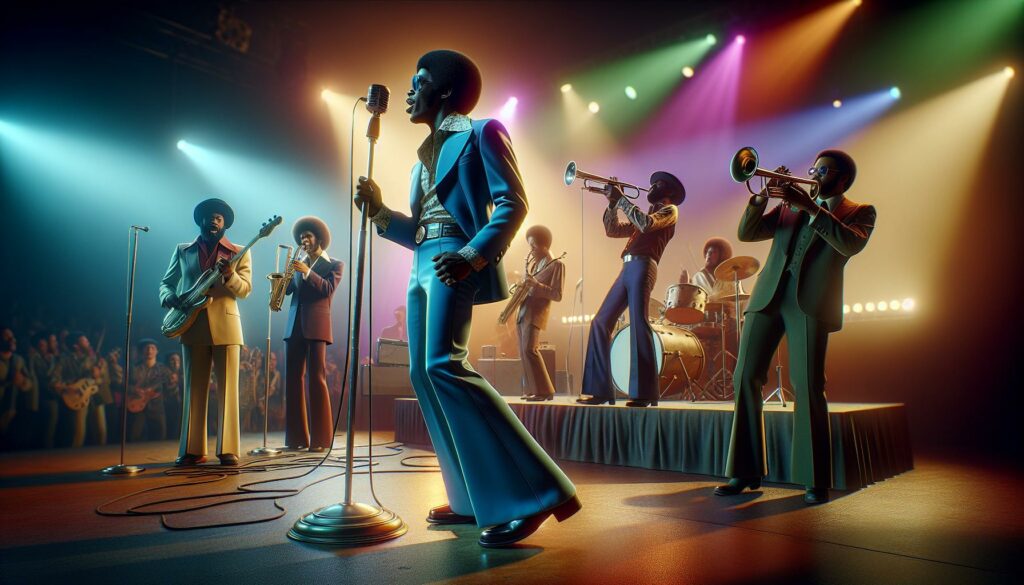As a lifelong music enthusiast, I’ve always been captivated by the raw emotion and powerful vocals that define soul music. This iconic genre emerged in the 1950s from African American gospel, R&B and jazz influences creating a sound that would forever change the landscape of popular music. When I think about soul music I’m reminded of legendary artists like Aretha Franklin Sam Cooke and Otis Redding who poured their hearts into every note. Their passionate performances and deeply moving lyrics spoke to the human experience in ways that transcended racial and cultural boundaries. Today soul music’s legacy lives on through modern artists who continue to draw inspiration from its rich heritage while adding their own contemporary twist to this timeless sound.
- Soul music emerged in the 1950s as a fusion of African American gospel, R&B, and jazz, pioneered by legends like Ray Charles and Sam Cooke
- The genre is characterized by powerful vocals, emotional delivery, distinctive instrumental elements like horn sections and Hammond organs, and gospel-influenced melismas
- Motown Records and Stax Records played pivotal roles in soul music’s golden age, with Motown offering polished production and Stax delivering raw, Southern soul
- Key artists like James Brown, Otis Redding, and Aretha Franklin transformed the genre through their innovative vocal techniques and dynamic performances
- Soul music’s influence extends into modern genres, inspiring R&B, neo-soul, and hip-hop, with its legacy carried forward by contemporary artists
Soul Music Genre
Soul music emerged as a distinct genre in the 1950s, blending African American gospel, rhythm and blues, and jazz elements into an emotionally charged musical style. The genre’s foundation lies in its ability to express deep human emotions through powerful vocals and compelling instrumentation.
The Birth of Soul in the 1950s
Soul music’s establishment traces back to Ray Charles’s groundbreaking fusion of R&B with gospel music in 1954. Notable early recordings include:
- “”I Got a Woman”” by Ray Charles (1954)
- “”You Send Me”” by Sam Cooke (1957)
- “”What’d I Say”” by Ray Charles (1959)
The genre gained prominence through record labels like:
- Stax Records in Memphis
- Motown Records in Detroit
- Atlantic Records in New York
Key Musical Elements of Soul
Soul music incorporates distinct musical characteristics:
- Vocal Techniques
- Call-and-response patterns
- Gospel-influenced melismas
- Intense emotional delivery
- Improvisational phrasing
- Instrumental Features
- Horn sections
- Hammond organ
- Electric bass
- Rhythmic guitar patterns
- Structural Components
- 12-bar blues progressions
- Verse-chorus format
- Extended instrumental breaks
- Strong rhythmic emphasis
| Element | Description |
|---|---|
| Tempo | 75-100 BPM (medium tempo) |
| Time Signature | 4/4 time |
| Key Elements | Gospel chord progressions |
| Vocal Range | Wide dynamic range |
| Production | Live recording emphasis |
Pioneers of Soul Music
The foundations of soul music rest on the contributions of transformative artists who shaped its sound in the 1950s and 1960s. These pioneering musicians established the genre’s signature elements through their innovative approaches to rhythm, melody, and vocal expression.
Ray Charles and Sam Cooke
Ray Charles revolutionized music by blending gospel fervor with R&B rhythms, earning him the title “”Father of Soul Music.”” His 1954 hit “”I Got a Woman”” marked the first fusion of secular lyrics with church-style call-and-response patterns. Sam Cooke’s transition from gospel to pop music created a template for soul vocalists, demonstrated in his smooth delivery on “”You Send Me”” (1957). Their collective innovations include:
- Incorporating gospel piano techniques into R&B arrangements
- Developing melodic patterns that emphasized emotional expression
- Creating crossover appeal between gospel and secular audiences
- Establishing vocal techniques like melisma in popular music
James Brown and Otis Redding
James Brown transformed soul music with his dynamic stage presence and rhythmic innovations that laid the groundwork for funk. His 1962 recording “”Live at the Apollo”” captured the raw energy of soul performance. Otis Redding brought intensity to Southern soul through recordings at Stax Records, including:
- Introducing syncopated horn arrangements
- Developing the grunt-and-groan vocal style
- Creating call-and-response patterns between vocals and instruments
- Establishing Memphis soul’s distinctive sound through raw emotional delivery
| Artist | Signature Song | Year | Impact |
|---|---|---|---|
| James Brown | “”Papa’s Got a Brand New Bag”” | 1965 | Introduced funk elements |
| Otis Redding | “”(Sittin’ On) The Dock of the Bay”” | 1968 | Bridged soul and pop |
| Ray Charles | “”What’d I Say”” | 1959 | Pioneered soul arrangement |
| Sam Cooke | “”A Change Is Gonna Come”” | 1964 | Defined protest soul |
The Golden Age of Soul
The 1960s marked the pinnacle of soul music’s cultural influence through iconic record labels Motown Records in Detroit and Stax Records in Memphis. These powerhouse labels established distinct sounds that shaped soul music’s evolution during its most prosperous era.
Motown Records and Its Impact
Berry Gordy Jr. founded Motown Records in 1959, creating a polished soul sound dubbed “”The Sound of Young America.”” The label’s signature elements included sophisticated arrangements, string sections, prominent tambourines and synchronized vocal harmonies. Notable Motown artists transformed soul music:
- The Supremes topped the Billboard charts 12 times between 1964-1969
- Marvin Gaye recorded groundbreaking albums like “”What’s Going On”” (1971)
- Stevie Wonder released innovative works including “”Songs in the Key of Life”” (1976)
- The Temptations pioneered psychedelic soul with “”Cloud Nine”” (1968)
| Motown Achievement | Statistics |
|---|---|
| Number 1 Hits (1960s) | 79 |
| Gold Records | 307 |
| Total Record Sales | 180+ million |
Stax Records and Southern Soul
Stax Records emerged as Motown’s grittier counterpart, championing raw Memphis soul with prominent horns and gospel-influenced vocals. The label’s house band, Booker T. & the M.G.’s, created distinctive backing tracks characterized by:
- Memphis Horns section featuring Wayne Jackson and Andrew Love
- Steve Cropper’s sharp guitar riffs
- Duck Dunn’s prominent bass lines
- Al Jackson Jr.’s precise drumming
- Otis Redding with “”(Sittin’ On) The Dock of the Bay””
- Sam & Dave performing “”Soul Man””
- Isaac Hayes creating the groundbreaking “”Hot Buttered Soul””
- The Staple Singers mixing gospel with soul in “”I’ll Take You There””
| Stax Milestones | Year |
|---|---|
| First Hit Single | 1961 |
| Peak Production | 1968 |
| Grammy Awards | 8 |
Soul Music’s Influence on Other Genres
Soul music revolutionized the music industry by inspiring numerous genres through its distinctive rhythms, vocal techniques, and emotional depth. Its influence permeates contemporary music, from R&B to hip-hop.
R&B and Modern Soul
Soul music directly shaped modern R&B through its emphasis on powerful vocals and emotional storytelling. Artists like Beyoncé, Alicia Keys and John Legend incorporate soul elements in their music, such as melismatic singing, call-and-response patterns and gospel-inspired harmonies. The fusion of soul with contemporary production techniques created signature sounds in hits like “”Listen”” by Beyoncé and “”Ordinary People”” by John Legend. Modern R&B artists frequently sample classic soul recordings, with notable examples including Mary J. Blige’s use of The Dramatics in “”My Life”” and Kanye West sampling Curtis Mayfield in “”Touch the Sky.””
Neo-Soul Movement
Neo-soul emerged in the 1990s as a conscious return to soul music’s organic roots. D’Angelo’s “”Brown Sugar”” (1995) and Erykah Badu’s “”Baduizm”” (1997) established the genre’s foundation by blending traditional soul elements with jazz harmonies and hip-hop production. The movement expanded through artists like Maxwell, Jill Scott and Lauryn Hill, who incorporated live instrumentation, complex arrangements and socially conscious lyrics. Neo-soul productions typically feature vintage recording techniques, analog instruments and minimal digital processing to maintain authenticity. Artists in this genre often collaborate with classic soul musicians, creating cross-generational projects that bridge traditional and contemporary styles.
Notable Soul Artists and Their Legacy
Soul music’s enduring influence stems from pioneering artists who shaped its sound through powerful vocals emotional depth. These artists created timeless recordings that continue to influence modern musicians across multiple genres.
Female Soul Icons
Aretha Franklin leads soul music’s female pantheon with 20 Grammy Awards 75 million records sold. Her signature songs “”Respect”” “”Natural Woman”” showcased unparalleled vocal power political consciousness. Diana Ross transformed The Supremes into Motown’s most successful act with 12 number-one hits between 1964-1969. Additional notable female soul artists include:
- Gladys Knight earned 7 Grammy Awards with hits “”Midnight Train to Georgia”” “”Neither One of Us””
- Patti LaBelle revolutionized soul with her 4-octave range theatrical performances
- Tina Turner sold 100 million records worldwide blending soul rock elements
- Etta James influenced generations with her raw emotional delivery iconic “”At Last””
Evolution of Soul Through the Decades
1960s marked soul music’s commercial peak with distinct regional sounds emerging:
| Decade | Key Developments | Notable Artists |
|---|---|---|
| 1960s | Motown Sound Detroit Soul | The Temptations Marvin Gaye |
| 1970s | Funk Integration Disco Influence | Curtis Mayfield Al Green |
| 1980s | Quiet Storm Contemporary R&B | Luther Vandross Anita Baker |
| 1990s | Neo-Soul Movement | D’Angelo Erykah Badu |
| 2000s | Retro-Soul Revival | Amy Winehouse Sharon Jones |
The evolution brought new elements to traditional soul:
- Memphis Sound incorporated raw horns gritty vocals
- Philadelphia Soul added orchestral arrangements smooth production
- Chicago Soul featured gospel-influenced harmonies brass sections
- Southern Soul emphasized guitar-driven arrangements deep grooves
These regional variations created distinct musical identities influenced contemporary artists across multiple genres.
Soul music stands as one of the most influential and enduring genres in music history. I’ve explored its incredible journey from gospel roots to mainstream success and its lasting impact on today’s music landscape.
From Ray Charles to Aretha Franklin the soul pioneers carved out a sound that continues to inspire generations of artists. I’m convinced that soul music’s emotional depth raw power and authenticity have secured its place as more than just a genre – it’s a cultural touchstone that speaks to the very essence of human experience.
As we look to the future I believe soul music’s influence will continue to shape and inspire new generations of musicians keeping its spirit alive while evolving in exciting new directions.



